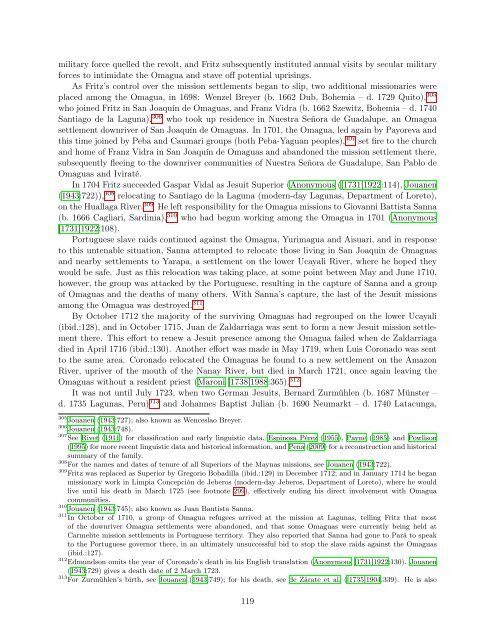draft manuscript - Linguistics - University of California, Berkeley
draft manuscript - Linguistics - University of California, Berkeley
draft manuscript - Linguistics - University of California, Berkeley
You also want an ePaper? Increase the reach of your titles
YUMPU automatically turns print PDFs into web optimized ePapers that Google loves.
military force quelled the revolt, and Fritz subsequently instituted annual visits by secular military<br />
forces to intimidate the Omagua and stave <strong>of</strong>f potential uprisings.<br />
As Fritz’s control over the mission settlements began to slip, two additional missionaries were<br />
placed among the Omagua, in 1698: Wenzel Breyer (b. 1662 Dub, Bohemia – d. 1729 Quito), 305<br />
who joined Fritz in San Joaquín de Omaguas, and Franz Vidra (b. 1662 Szewitz, Bohemia – d. 1740<br />
Santiago de la Laguna), 306 who took up residence in Nuestra Señora de Guadalupe, an Omagua<br />
settlement downriver <strong>of</strong> San Joaquín de Omaguas. In 1701, the Omagua, led again by Payoreva and<br />
this time joined by Peba and Caumari groups (both Peba-Yaguan peoples), 307 set fire to the church<br />
and home <strong>of</strong> Franz Vidra in San Joaquín de Omaguas and abandoned the mission settlement there,<br />
subsequently fleeing to the downriver communities <strong>of</strong> Nuestra Señora de Guadalupe, San Pablo de<br />
Omaguas and Iviraté.<br />
In 1704 Fritz succeeded Gaspar Vidal as Jesuit Superior (Anonymous ([1731]1922:114), Jouanen<br />
(1943:722)), 308 relocating to Santiago de la Laguna (modern-day Lagunas, Department <strong>of</strong> Loreto),<br />
on the Huallaga River. 309 He left responsibility for the Omagua missions to Giovanni Battista Sanna<br />
(b. 1666 Cagliari, Sardinia), 310 who had begun working among the Omagua in 1701 (Anonymous<br />
[1731]1922:108).<br />
Portuguese slave raids continued against the Omagua, Yurimagua and Aisuari, and in response<br />
to this untenable situation, Sanna attempted to relocate those living in San Joaquin de Omaguas<br />
and nearby settlements to Yarapa, a settlement on the lower Ucayali River, where he hoped they<br />
would be safe. Just as this relocation was taking place, at some point between May and June 1710,<br />
however, the group was attacked by the Portuguese, resulting in the capture <strong>of</strong> Sanna and a group<br />
<strong>of</strong> Omaguas and the deaths <strong>of</strong> many others. With Sanna’s capture, the last <strong>of</strong> the Jesuit missions<br />
among the Omagua was destroyed. 311<br />
By October 1712 the majority <strong>of</strong> the surviving Omaguas had regrouped on the lower Ucayali<br />
(ibid.:128), and in October 1715, Juan de Zaldarriaga was sent to form a new Jesuit mission settlement<br />
there. This effort to renew a Jesuit presence among the Omagua failed when de Zaldarriaga<br />
died in April 1716 (ibid.:130). Another effort was made in May 1719, when Luis Coronado was sent<br />
to the same area. Coronado relocated the Omaguas he found to a new settlement on the Amazon<br />
River, upriver <strong>of</strong> the mouth <strong>of</strong> the Nanay River, but died in March 1721, once again leaving the<br />
Omaguas without a resident priest (Maroni [1738]1988:365). 312<br />
It was not until July 1723, when two German Jesuits, Bernard Zurmühlen (b. 1687 Münster –<br />
d. 1735 Lagunas, Peru) 313 and Johannes Baptist Julian (b. 1690 Neumarkt – d. 1740 Latacunga,<br />
305 Jouanen (1943:727); also known as Wenceslao Breyer.<br />
306 Jouanen (1943:748).<br />
307 See Rivet (1911) for classification and early linguistic data, Espinosa Pérez (1955), Payne (1985) and Powlison<br />
(1995) for more recent linguistic data and historical information, and Pena (2009) for a reconstruction and historical<br />
summary <strong>of</strong> the family.<br />
308 For the names and dates <strong>of</strong> tenure <strong>of</strong> all Superiors <strong>of</strong> the Maynas missions, see Jouanen (1943:722).<br />
309 Fritz was replaced as Superior by Gregorio Bobadilla (ibid.:129) in December 1712; and in January 1714 he began<br />
missionary work in Limpia Concepción de Jeberos (modern-day Jeberos, Department <strong>of</strong> Loreto), where he would<br />
live until his death in March 1725 (see footnote 299), effectively ending his direct involvement with Omagua<br />
communities.<br />
310 Jouanen (1943:745); also known as Juan Bautista Sanna.<br />
311 In October <strong>of</strong> 1710, a group <strong>of</strong> Omagua refugees arrived at the mission at Lagunas, telling Fritz that most<br />
<strong>of</strong> the downriver Omagua settlements were abandoned, and that some Omaguas were currently being held at<br />
Carmelite mission settlements in Portuguese territory. They also reported that Sanna had gone to Pará to speak<br />
to the Portuguese governor there, in an ultimately unsuccessful bid to stop the slave raids against the Omaguas<br />
(ibid.:127).<br />
312 Edmundson omits the year <strong>of</strong> Coronado’s death in his English translation (Anonymous [1731]1922:130). Jouanen<br />
(1943:729) gives a death date <strong>of</strong> 2 March 1723.<br />
313 For Zurmühlen’s birth, see Jouanen (1943:749); for his death, see de Zárate et al. ([1735]1904:339). He is also<br />
119
















